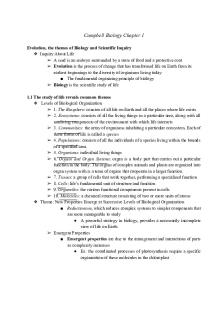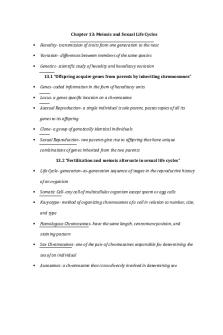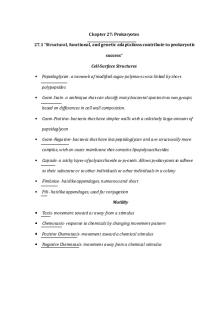Campbell Biology Chapter 1 PDF

| Title | Campbell Biology Chapter 1 |
|---|---|
| Course | Principles of Molecular & Cellular Biology |
| Institution | University of Maryland |
| Pages | 8 |
| File Size | 480.9 KB |
| File Type | |
| Total Downloads | 108 |
| Total Views | 158 |
Summary
Download Campbell Biology Chapter 1 PDF
Description
Campbell Biology Chapter 1 Evolution, the themes of Biology and Scientific Inquiry ❖ Inquiry About Life ➢ A seed is an embryo surrounded by a store of food and a protective coat ➢ Evolution is the process of change that has transformed life on Earth from its earliest beginnings to the diversity of organisms living today ■ The fundamental organizing principle of biology ➢ Biology is the scientific study of life 1.1 The study of life reveals common themes ❖ Levels of Biological Organization ➢ 1. The Biosphere: consists of all life on Earth and all the places where life exists ➢ 2. Ecosystems: consists of all the living things in a particular area, along with all nonliving components of the environment with which life interacts ➢ 3. Communities: the array of organisms inhabiting a particular ecosystem. Each of these forms of life is called a species ➢ 4. Populations: consists of all the individuals of a species living within the bounds of a specified area. ➢ 5. Organisms: individual living things ➢ 6. Organs and Organ Systems: organ is a body part that carries out a particular function in the body. The organs of complex animals and plants are organized into organ system with is a team of organs that cooperate in a larger function ➢ 7. Tissues: a group of cells that work together, performing a specialized function ➢ 8. Cells : life’s fundamental unit of structure and function ➢ 9. Organelles: the various functional components present in cells ➢ 10. Molecules : a chemical structure consisting of two or more units of atoms ❖ Theme: New Properties Emerge at Successive Levels of Biological Organization ■ Reductionism, which reduces complex systems to simpler components that are more manageable to study ● A powerful strategy in biology, provides a necessarily incomplete view of life on Earth ➢ Emergent Properties ■ Emergent properties are due to the arrangement and interactions of parts as complexity increases ● Ex: the coordinated processes of photosynthesis require a specific organization of these molecules in the chloroplast
■ Isolated components of living systems, serving as the objects of study in a reductionist approach to biology lack a number of significant properties that emerge at higher levels of organization ■ Systems biology is the exploration of a biological system by analyzing the interaction among its parts ● By examining and modeling the dynamic behavior of an integrated network of components, the systems biology enables us to pose new kinds of questions. ➢ Structure and Function ■ Analyzing a biological structure gives us clues about what it does and how it works ■ Knowing the function of something provides insight into its structure and organization ➢ The Cell: An Organism’s basic Unit of Structure and Function ■ Cell is the smallest unit of organization that can perform all activities required for life ■ Every cell is enclosed by a membrane that regulates the passage of materials between the cell and its surroundings ■ Prokaryotic cells are cells of two groups of single-celled microorganisms bacteria (singular, bacterium) and archaea (singular, archaean), have no nucleus and membrane-enclosed organelles ■ Eukaryotic cells contain membrane-enclosed organelles, present in both plants and animals
■ contrast the difference in size ❖ Theme: Life’s Processes Involve the Expression and Transmission of Genetic Information ■ Within cells, structures called chromo- somes contain genetic material in the form of DNA (deoxy- ribonucleic acid)
● chromosomes may be made visible using a dye that appears blue when bound to the DNA ➢ DNA, the Genetic Material ■ When a cell divides, the DNA first replicated and the two cellular offspring inherits a complete set of chromosomes, identical to that of the parent cell ■ Genes, a section of the DNA of the chromosome, encode the information necessary and establish that cell’s identity and function. ■ DNA is made up of two long chains, called strands. ● Each chain is made up of four kinds of chemical building blocks called nucleotides, abbreviated A, T, C, and G ■ Gene control protein production using RNA as an intermediary. ● The sequence of nucleotides along a gene is transcribed into RNA, which is then translated into a linked series of protein building blocks called amino acids ■ Gene expression is the process in which the information in a gene directs the manufacture of a cellular product ■ Differences between organisms reflect differences between their nucleotide sequences rather than between their genetic codes ➢ Genomics: Large-Scale Analysis of DNA Sequences ■ Genome is the entire “library” of genetic instructions that an organ- ism inherits ■ Genomics is the study of whole sets of genes (or other DNA) in one or more species ■ Proteomics is the study of sets of proteins and their properties. ● The entire set of proteins expressed by a given cell or group of cells is called a proteome ■ Three important research developments have made the genomic and proteomic approaches possible ● “high-throughput” technology: tools that can analyze many biological samples very rapidly ● Bioinformatics: the use of computational tools to store, organize, and analyze the huge volume of data that results from high-throughput methods ● Formation of interdisciplinary research teams: groups of diverse specialists from a variety of fields ❖ Theme: Life Requires Transfer and Transformation of Energy and Matter
■ When an organism uses chemical energy to perform work, such as muscle contraction or cell division, some of that energy is lost to the surroundings as heat ● Energy flows one way through an ecosystem, usually enter- ing as light and exiting as heat ● Chemicals are recycled within an ecosystem ◆ Ex: Chemicals that a plant absorbs from the air or soil may be incorporated into the plant’s body and then passed to an animal that eats the plant. Eventually, these chemicals will be returned to the environment by decomposers ● ❖ Theme: From Ecosystems to Molecules, Interactions Are Important in Biological System ➢ Ecosystems: An organism’s Interactions with Other Organisms and the Physical Environment ■ Interactions among organisms help regulate the functioning of the ecosystem as a whole ● It could be mutually beneficial, it could be benefiting one species while hurting another, or both species can be harmed ■ Organisms also interact continuously with physical fac- tors in their environment ● The environment is also affected by the organisms living there ➢ Molecule: Interactions Within Organisms ■ Most chemical activities in the cell, those that either decompose or store sugar are accelerated at the molecular level (catalyzed) by proteins called enzymes. ● Each type of enzyme catalyzes a specific chemical reaction ■ The key is the ability of many biological processes to self- regulate by a mechanism called feedback ■ In feedback regulation, the output, or product, of a process regulates that very process ● negative feedback , a loop in which the response reduces the initial stimulus ◆ Ex: insulin signaling, the uptake of glucose by cells (the response) decreases blood glucose levels ● positive feedback , in which an end product speeds up its own production ◆ Ex: clotting of blood in response to injury ◆ Occurs as chemicals released by the platelets attract more platelets
1.2 The Core Theme: Evolution accounts for the unity and diversity of life ■ Evolutionary mechanisms ac- count for the unity and diversity of all species on Earth ❖ Classifying the Diversity of Life ➢ Grouping Species: The Basic Idea ■ Taxonomy, the branch of biology that names and classifies species, formalizes this ordering of species into groups of increasing breadth, based on the degree to which they share characteristics ■ The kingdoms of life can be grouped into three even higher levels of classification called domains ● Bacteria and Archaea made up two of the three domains, they are both prokaryotic ● All eukaryotes (organisms with eukaryotic cells) are now grouped in domain Eukarya ■ Eukarya includes three kingdoms of multicellular eukaryotes ● Kingdoms Plantae: Produce their own sugars and other food molecules by photosynthesis, ● Kingdoms Fungi: Absorb dissolved nutrients from their surroundings ● Kingdoms Animalia: Obtain food by eating and digesting other organisms ❖ Charles Darwin and the Theory of Natural Selection ■ Contemporary species arose from a succession of ancestors that differed from them, this process is called “descent with modification” ■ “natural selection” is an evolutionary mechanism for descent with modification. ■ Natural selection is the natural environment “selects” for the propagation of certain traits among naturally occurring variant traits in the population 1.3 In studying nature, scientists make observations and form and test hypotheses ■ Science is a way of knowing—an approach to understanding the natural world ● It is inquiry, a search for informa- tion and explanations of natural phenomena ● use a process of inquiry that includes making observations, forming logical, testable hypotheses , and testing them ❖ Making Observations
■ Observation is the gather- ing of information, either through direct use of the senses or with the help of tools ■ Data are items of information on which scientific inquiry is based ● Qualitative : in the form of recorded descriptions ● Quantitative : in form of numerical measurement ■ Inductive reasoning is a type of logic that can lead to important conclusion based on the collection and analyzation of observations ❖ Forming and Testing Hypotheses ■ Hypothesis is a tentative answer to a well framed question ● A rational account for a set of observations, based on the available data and guided by inductive reasoning ➢ Deductive Reasoning ■ Deductive reasoning involves logic that flows in the opposite direction, from the general to the specific ● Usually take the form of predictions of results that will be found if a particular hypothesis (premise) is correct ● Follows the “If . . . then” logic ➢ Questions That Can and Cannot Be Addressed by Science ■ A scientific hypothesis must be testable ; there must be some observation or experiment that could reveal if such an idea is likely to be true or false ❖ Experimental Variables and Controls ■ An experiment involves manipulation of one factor in a system in order to see the effects of changing it ■ Variables: factors that vary in an experiment ■ Controlled experiment: designed to compare an experimental group with a control group ● everything is kept constant except the one variable ■ Independent variable: a factor that is being manipulated ■ Dependent variable: a factor that is measured in the experiment ❖ Theories in Science ■ Theory is much broader in scope than a hypothesis ● Generally supported by a much greater body of evidence 1.4 Science benefits from a cooperative approach and diverse view point ❖ Building on the Work of Others ■ Model organism: a species that is easy to grow in the lab and lends itself particularly well to the questions being investigated ❖ Science, Technology, and Society ■ Science is to understand natural phenomena
■ Technology is to apply scientific knowledge for some specific purpose...
Similar Free PDFs

Campbell Biology Chapter 1
- 8 Pages

Chapter 8 (campbell biology)
- 8 Pages

Ch26 - Summary Campbell Biology
- 6 Pages
Popular Institutions
- Tinajero National High School - Annex
- Politeknik Caltex Riau
- Yokohama City University
- SGT University
- University of Al-Qadisiyah
- Divine Word College of Vigan
- Techniek College Rotterdam
- Universidade de Santiago
- Universiti Teknologi MARA Cawangan Johor Kampus Pasir Gudang
- Poltekkes Kemenkes Yogyakarta
- Baguio City National High School
- Colegio san marcos
- preparatoria uno
- Centro de Bachillerato Tecnológico Industrial y de Servicios No. 107
- Dalian Maritime University
- Quang Trung Secondary School
- Colegio Tecnológico en Informática
- Corporación Regional de Educación Superior
- Grupo CEDVA
- Dar Al Uloom University
- Centro de Estudios Preuniversitarios de la Universidad Nacional de Ingeniería
- 上智大学
- Aakash International School, Nuna Majara
- San Felipe Neri Catholic School
- Kang Chiao International School - New Taipei City
- Misamis Occidental National High School
- Institución Educativa Escuela Normal Juan Ladrilleros
- Kolehiyo ng Pantukan
- Batanes State College
- Instituto Continental
- Sekolah Menengah Kejuruan Kesehatan Kaltara (Tarakan)
- Colegio de La Inmaculada Concepcion - Cebu












